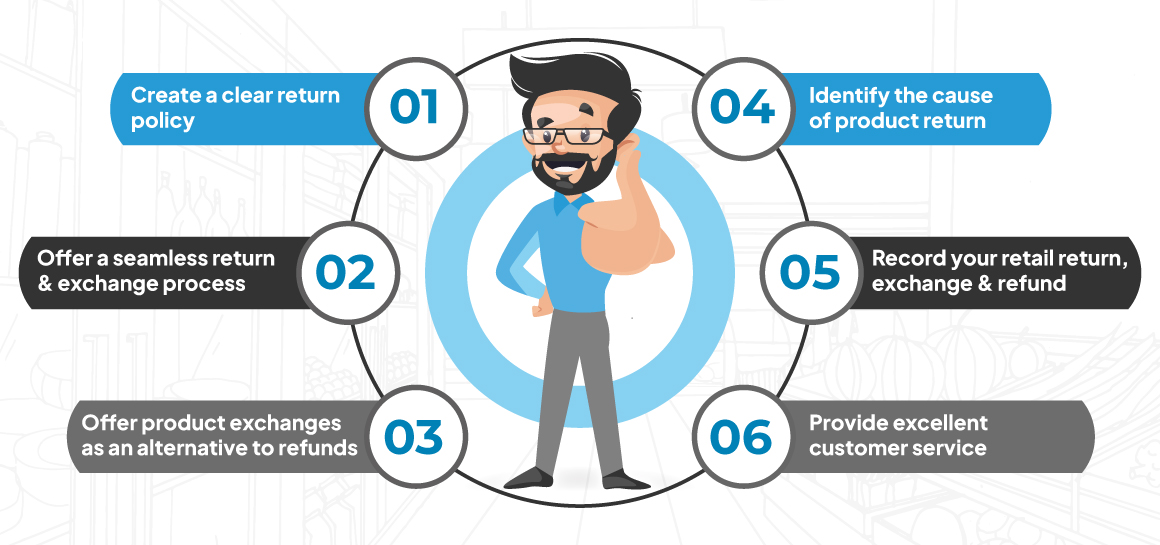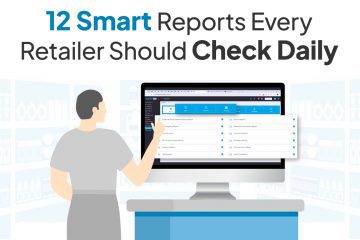How do you Manage Returns and Exchanges in a Retail Business?
March 28, 2024

Receiving products in return and exchange is very common for any retail business. Even the most successful business has a regular flow of product returns.
A product return occurs when a customer brings a purchased product and asks for its refund or replacement. For instance, a customer wants a pair of shoes to return due to its small size.
However, returns done properly improve customer satisfaction and trust. But, if done wrongly results, in losing customer trust and loyalty.
It is observed that 84% of customers would not return to a retailer after an unfriendly returns experience.
Hence, retailers need to frame strong return policy guidelines. It streamlines the return and exchange process, helps you overcome too many losses, records all return transactions, and keeps customers happy.
Let’s discuss the best practices retailers can follow to manage returns and exchanges in the retail business.
Receiving an unsatisfied product can easily disappoint customers, offering them a choice to look at other alternatives.
Receiving frequent product returns reduces your profit margin, loses customer trust, and poses a threat to your business.
But still, retailers overlook returns. The reasons are a lack of operational challenges, inability to satisfy customers, and limited knowledge of integrated POS systems that come with accounting management features.
VasyERP offers the best online accounting software to manage your return in a user-friendly manner.
There are benefits to managing retail returns in the best possible way:
1. Builds customer loyalty
A smooth return and exchange process creates a positive impact on your brand. Once the customer is satisfied with your exchange policy, he will choose you for his next shopping. It will not let your consumer look at another brand.
92% of consumers will buy again if returns are easy.
Your customer repeat rate will increase, setting you apart from your competitors.
2. Preserves brand reputation
Your return and exchange policy defines your brand reputation. You can even highlight your brand on a commercial website like Indiamart.com, where people write product reviews. Online reviews are a measuring tool to gain trust in your brand.
Delivering quality customer experience through goods exchange increases the likelihood of gaining positive reviews and word-of-mouth marketing. You may use this free promotion to boost new and repeat sales and support the long-term viability of your company.
The retail store in India is expected to reach a whopping US$ 2 trillion in value by 2032, according to a recent analysis by Boston Consulting Unit (BSC).

Receiving returns is an unavoidable factor of the retail market, but how you handle them can differentiate your company’s performance.
A return policy is a set of rules that specify conditions in which a buyer may return a product. A return policy is clear, concise, and fair for you and your consumers. It prevents any confusion and sets clear expectations.
Steps to create a return policy:
a. Define eligibility: Create a list of products eligible for return under specific conditions, like household products, clothes, books, or jewelry.
b. Set timeframe: Establish a specific period for customers to return merchandise. It guarantees quick return processing and avoids policy misuse.
c. Clear refund options: Determine how much refund you will offer on return. It is Full or partial or else exchanging product. Your refund options should not violate customers’ faith in your brand.
d. Communicate your return policy: Explain it to your customers and make it easily accessible. Include your packaging, website, and other correspondence address. Communication is crucial when it comes to handling goods returns. While drafting your return policy, keep it clear and write in easy-to-understand language. I suggest you avoid any jargon terms.
Make your return and exchange process as easy as possible. It offers a positive experience for your customers and encourages them to shop from your store.
Create an easy-to-understand return policy to streamline your return process. Give clients clear information on how to start a return process. Think about providing a variety of return alternatives, including mail-in, in-store, and online returns.
Mention clearly in your return policy about how to pack the return product and where to drop it off. At the shop, provide return labels for products mentioning the reason for return.
Product refunds do not count as revenue. In this process, an amount is debited from the retailer’s account and transferred to the customer’s account, causing financial loss.
You can overcome this by offering a product exchange instead of returning the amount. This approach can benefit both the parties. The unhappy customers may appreciate the option to exchange the item rather than a refund. It helps retain customers and encourages them to make future purchases.
From a business perspective, it reduces the financial impact of returns. You can offer another product in exchange for a returned product of equal value, ensuring that you still make a sale. It helps move inventory and reduce the risk of overstocking certain products.
If you are receiving complaints about product returns, identify the root cause and take steps to avoid it in the future.
Some common reasons are:
After returning or exchanging the product, ask your sales team to collect customer feedback. It helps you to work on your product’s weak areas and deliver customer-centric products. Ask your quality control team to check products with the maximum return complaints. Take proactive steps to resolve the problem and prevent deterring your image.
Keep track of the quantity, price, returns percentage, and reason for each return. You can compare your return rate with competitors and the industry average rate. This data helps you to analyze your performance and profitability. Use this information to identify and address any issues or opportunities in your business procedure.
Retailers can easily track consumers’ data using our cloud-based accounting software. They use credit cards for shopping by consumers. You can verify consumer ID and credit card details to ensure the return is not fraudulent. Retail software allows you to create a database of returns and exchange products, making it convenient to detect customers abusing the system.
Make the return and exchange process fast. Dedicate a separate counter for product refunds and exchange. Make sure to offer a point of sale that can easily accommodate returned items within existing stock.
Avoid asking too many questions; it irritates consumers to answer. Ask them to return the item along with the price tag and invoice.
Online retailers can dedicate a customer service team to look at product return and exchange calls. It helps the customer to update about the collection of returning orders and receiving refunds. Train all employees to process returns and exchange proceedings. The process will be fast and hassle-free. There is more chance of customer retention.
Never disappoint yourself due to the high retail return. The best products also get returns too. It is an opportunity to upgrade your business, analyze the market, and create products that satisfy consumers.
VasyERP offers a comprehensive retail software solution to update real-time return and exchange processes, manage inventory, and improve overall business performance. The software can easily track returns, analyze data, and provide exceptional customer service for online and offline stores, ultimately driving growth and profitability.
Don’t wait; upgrade your retail business with VasyERP today and stay ahead in the competitive retail market!

This blog explains the list of smart retail reports tha...
July 18, 2025

Are you a retailer or wholesaler looking to create full...
September 11, 2024
